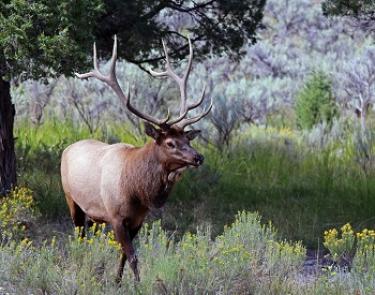What are Elk Doing in Your Woods?
In spring and summer when there is plenty of food available elk are mainly grazers, eating grasses, sedges and flowering plants. They eat almost constantly, working to get their body weight up while plant life is plentiful. In fall, when food becomes more scarce, they become browsers, eating branches of shrubs and trees, including conifers when winter sets in.
Elk are social animals and will generally be found in herds, often grouping by sex outside of breeding season. Female herds can be quite large–up to 50 individuals. Breeding takes place in fall with much fanfare. Like others in the deer family, elk have ritualized mating behaviors, but elk have elevated this practice to a spectacle. It is something to behold an enormous bull elk in late fall, with full-grown antlers that can reach 4 feet in length. Bulls begin by posturing, jousting with other males and following females around. Their glass-shattering bugling attracts females and wards off other males. Bugling can be heard for miles and often consists of a series of groaning, high-pitched whistling and grunting. (link to audio of bugling)
Mating will usually end by mid-October, and calves are born the following May or June. Mothers may leave the herd to give birth, and stay hidden with their calves for several weeks, until the young elk are old enough to outrun predators. A calf can gain a huge amount of weight in a very short time, often as many as 200 pounds before the onset of winter.
Though they graze in meadows and browse at the forest edge, elk also use the forest interior for shelter and cover from common predators, including cougars, wolves, coyotes and people, as well as bear and bobcat for young and injured elk.
How can I get more tips?
It’s simple! Enter your email below.

